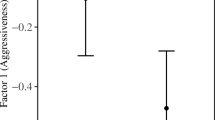Abstract
The role of sex and breeding status constraints on grooming behavior and tick load in impala was examined among females, bachelor males (B males), and territorial males (T males) during the breeding season in Zimbabwe. T males orally groomed themselves much less than females or B males, whereas B males orally groomed themselves at a higher rate than, but not significantly different from, females. T males never engaged in allogrooming and B males allogroomed at a low rate that was not significantly different from that of T males; all males allogroomed much less than females. There was no difference in any of the grooming measures between T males with a breeding herd in residence, and solitary T males without a breeding herd on the territory. In conjunction with a management exercise, culled impala were examined for total tick burden using the digestion method, by which all ticks (larvae, nymphs, adults) are removed and counted. For all developmental stages, females harbored the fewest number of ticks and T males supported the most; tick loads of B males were intermediate to those of females and T males. When body surface area was taken into account, T males harbored a higher density of ticks than females and B males. All sex-breeding status groups supported a higher density of ticks on the head/neck region (inaccessible to self oral grooming) compared with accessible areas of the body. The results support the programmed grooming hypothesis, which predicts that those individuals that groom most will harbor fewest ticks, in contrast to the stimulus-driven model which predicts that those that groom most will harbor the most ticks. The lower grooming rates of males versus females can be attributed to competing behavioral demands on males for vigilance and rutting behavior during the breeding season, and/or to higher testosterone levels exerting a physiological suppression of oral grooming. The higher number and density of ticks harbored by T males indicates that lowered grooming rate is a significant cost to reproductively active impala males during the breeding season.
Similar content being viewed by others
Author information
Authors and Affiliations
Additional information
Received: 8 September 1995/Accepted after revision: 7 July 1996
Rights and permissions
About this article
Cite this article
Mooring, M., McKenzie, A. & Hart, B. Role of sex and breeding status in grooming and total tick load of impala. Behav Ecol Sociobiol 39, 259–266 (1996). https://doi.org/10.1007/s002650050288
Issue Date:
DOI: https://doi.org/10.1007/s002650050288




